|
Cairo Temp & Time

 |
Conversion Money

|
|
|
|
|
Most visitors to Egypt visit the pyramids of Giza, one of the ancient seven wonders of the world.
Few visitors travel beyond these well known sites.
But Egypt has many more wonders to offer its visitors, from desert sunsets to sharing a delightful meal with the local Bedouin people. |
|
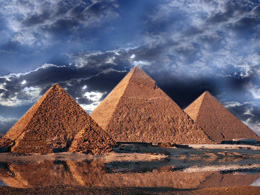 Cairo & Giza
Cairo at a Glance
Cairo - the modern capital of an ancient land-is magical, mystical, and mysterious.
It is itself a juxtaposition of the anachronistic and the modern. This extraordinary city, the largest in Egypt, and indeed all of Africa, simply cannot be missed. Islamic Cairo is truly a cultural and historical highlight of the city.
Its minarets and domes, bazaars, and cobblestone streets are straight from A Thousand and One Arabian Nights. But let Islamic Cairo be but a start to your explorations here.
From Central Cairo with its fine 19th century architecture to the Citadel of Saleh el-Din and the astonishing dome of the Alabaster Mosque to the haunting echoes of the City of the Dead Cairo beckons.
Giza and Heliopolis
Giza and Heliopolis are two Cairo suburbs that are not only geographically opposed, they also epitomize two extremes of Egypt's history. Giza, on the West Bank of Nile, is famed for its ancient monuments.
The Sphinx, dating back to 2500 BC and the earliest-known monumental sculpture, stands guard over the Great Pyramids at Giza and their attendant Queens' pyramids, temples and tombs.
The Pyramids are the only one of the Seven Wonders of the Ancient World to survive. Even the accompanying circus of camel and horse rides, souvenir and soft drinks vendors and the nightly Sound and Light show do not diminish their splendor. In the diagonally opposite suburb of Heliopolis, history moves on to the late 19th century and Baron Edouard Empain, the entrepreneur whose vision inspired his garden city in the desert.
Built in a mixture of European and Moorish styles, Heliopolis attracted wealthy Egyptians to its leafy grandeur. Although it is no longer separate from Cairo, visitors still come to enjoy its stylish architecture, restaurants and nightlife. |
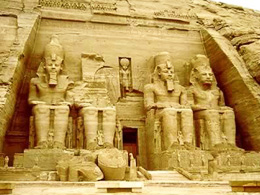 Aswan & Abu Simbel
Some 320 km outside of Aswan in Nubia lies what can only be described as the truly remarkable Temple of Abu Simbel. It was carved directly out of the sandstone cliffs along the Nile and built by Ramses II. Built under the pretense of dedication to the gods Amon Ra, Harmakis, and Ptah many would say it was built for Ramses own glorification. On the face of the temple are four huge statues of King Ramses II seated on his throne. Each individual statue is 20 meters high, four meters from ear-to-ear, and one meter across the mouth. Statues of Amon Ra, Harmakis, and Ptah once stood at the heart of the mountain from which this temple was carved.
Twice a year the sun would penetrate the entrance of the temple, into the mountain, and shine on Amon Ra and a statue of Ramses II. About 20 minutes later it would then move to shine on Harmakis but, interestingly enough, would fail to ever shine on Ptah, the God of Darkness. In the temple's yard, there is a group of monuments, the most important of which is the famous marital monument on which is registered the story of the marriage of the Pharaoh and the daughter of the Hethean King; after signing the first peace treaty in the world between Egypt and Khita.
In the hall of columns, there are eight huge pillars on which is sculpted the statue of Ramses taking the figure Osiris, the God of the Dead. This hall is also known for its northern wall on which is represented the Battle of Kadesh. The southern wall depicts a dazzling scene of the King and his sons attacking the Syrian citadel, and at the bottom we see a shepherd trying to escape the victorious King. Just beside this scene, the King is pictured again holding an enemy in one hand and stabbing him with the other. This scene is somewhat remarkable as the enemy appears to be of the same size as the King while in other scenes enemies were always humiliated by being smaller than the King. The Temple of Abu Simbel contains many other scenes of no less importance than the ones already described - indeed it is worthy of at least one full days exploration. Truly this is a temple not to be missed. |
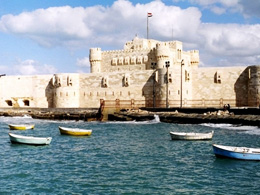 Alexandria
Alexandria was founded by Alexander the Great in 332 BC. However, he left it before laying a single stone. The city was then founded again after Alexander's death by one of his generals, Ptolemy I Soter. Alexandria played an important role in the development of mathematics, engineering and medicine as well as Christian thoughts. Now, Alexandria is Egypt's major port and the country's second largest city. Little of the ancient city did survive till today but its past still haunts the old streets. |
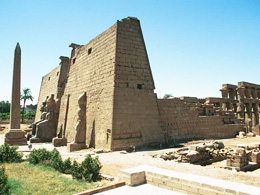 Luxor
Luxor is by far the richest area of ancient Egyptian history. It is the modern day city on the ancient site of Thebes, the capital of the New Kingdom. Here, on the East Bank of the Nile, you will find the city of Luxor. The most notable sites are the glorious Temple of Luxor and the Temple of Karnak, The Temple of Luxor is lit at night and is an unforgettable sight. In the evening at the Temple of Karnak there is a Sound & Light show - and it is quite the experience to walk through its columned halls in near darkness and hear the almost haunting sounds of its past.
On the West Bank of the Nile is the famed Valley of the Kings where the tombs of many pharaohs were discovered including King Tuts. However, there are many other historically significant and magnificent sites on the West Bank. These include the Valley of the Queens, the Colossi of Memnon, and the Temple of Queen Hatshepsut the only woman pharaoh.
Until Napoleon Bonapartes expedition in the late 18th century, Luxor was an unknown little village in the province of Qena. Later however, the expedition revealed the importance of the sites in and around Luxor. Since then, the number of tourists visiting the sites has increased enormously. Although there are daily flights and trains to Luxor most visitors prefer to visit Luxor as part of a cruise down the Nile. Seeing the sites of Upper Egypt while cruising down the Nile has often been described as a journey of a lifetime. |
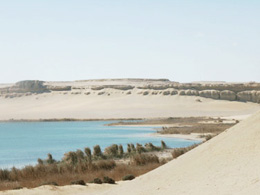 El Fayoum
The Province of El Fayoum is the largest and westernmost of the several oases scatterred across the western desert. It feeds on an off shoot of the Nile and is a center of a cultivated area. El Faiyum, being an isolated land provided protection to the early centers of christianity. After the Arab conquest, a large number of the population of El Faiyum accepted Islam and some Muslim bedouins came to settle in the area. However, it remained a great center of christianity for a long time. |
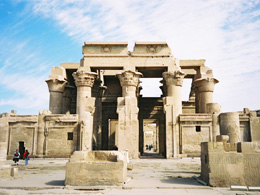 Kom-ombu & Edfu
Edfu was an important city in Upper Egypt, lying on the left bank of the Nile, about 100km south from Luxor. During the reign of the Old State, Edfu (the capital of the second province in Upper Egypt) enjoyed enormous prosperity. Nowadays, this city is known by its grand temple which was devoted to the worship of the great God of the Heavens falcon 'Horus', the God of Baholt town. This temple is considered one of the most important religious monuments in Egypt. During the reign of King Ptolomy III (237 B.C.), the construction of Edfu temple began, yet it was not finished until 57 B.C. because of some intrigues and plots hatched at Thebes at that time.
The length of the temple is 137m, while its width is 79m and its height 376m. Tourists are undoubtedly fascinated by the wonderful condition of the perfectly preserved temple, its buildings, ceilings, halls, etc... are all complete and intact so that one might imagine seeing the priests and their assistants in their snow-white robes wondering here and there. Furthermore, the temple is surrounded by a number of secondary buildings attached o the temple, such as the "Mammsi". It is noteworthy that the temple is characterized by an enormous quantity of inscriptions covering the walls. |
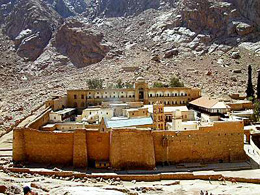 Sinai
History
Centuries of European traders and Arab merchants had to sail around the ape of Good Hope the southern most tip of Africa in order to travel East from Europe and the Mediterranean Sea thereby avoiding dangerous treks across the treacherous desert. Ancient Egyptians recognized this problem and the records of Herodotus, ancient Greek historian, bare evidence of a canal that was built around 600 B.C. connecting the Gulf of Suez with the Nile river. After several starts and stops, the project was finally completed about a century later. The canal was used during the time of Alexander the Great, left to ruin, then restored and reopened during the Arab domination around 645 A.D.
It was primarily used as a trading route connecting the Nile Valley with the trade center in Mecca, on the western coast of Saudi Arabia. No traces of this canal remain today as the sands of time have buried it forever. Finally, in 1859 upon French insistence, the manual digging of the Suez Canal began. It remained an independently run entity under European authority until Egyptian President Gamal Abdel Nasser nationalized the canal in 1956. Now crossing into Sinai is made easy by ferry, the A.H. Tunnel, or by plane. There are daily flights from Cairo, Luxor, Aswan, and several major European cities that fly directly into the domestic and international airport at Sharm el Sheikh.
Geography
Sinai is a triangular peninsula wedged in between the waters of the Gulf of Suez to its west and the Gulf of Aqaba to its east. The origin of the name "Sinai" can be attributed to two hypotheses. The ancient inhabitants of this desert adored and worshipped the Moon Goddess 'Sin', therefore perhaps in her honor naming their land "Sinai". "Sinai" is said to be derived from the Semitic word "sin" which means tooth. The peninsula does actually look like a tooth. Regardless of these hypotheses, how the peninsula was formed is certain. Forty million years ago, the Sinai was part of the African/Asian landmass until seismic activity began a process which split the landmass into two separate plates. Think of the Sinai as being pulled simultaneously by both Africa and Asia in virtually opposite directions. Such plate motion continued to influence the region thereby creating a protected underwater ecology, and vast uninhabited areas of rugged mountain terrain and arid desert: the Red Sea and Sinai.
People come to Sinai not just for its religious heritage, but to marvel at its pure beauty. The Bible connects Sinai with the exodus of the Children of Israel from Ancient Egypt. Modern Egyptian history connects Sinai with a series of territorial wars with neighboring Israel. After exploring Sinai, you will connect it with pristine nature and unadulterated beauty, practically untouched by time and preserved by its dry desert conditions. Its majestic scenery of colors ranging from deep purple to orange, yellow, and charcoal grey will be imprinted in your mind's eye or on your camera film forever.
The Sinai is divided into three geologically different areas. The first area lies to the north and consists mainly of shifting, pure and soft sand dunes. Herein lie ancient 'wadis' or dried up riverbeds where fossilized organisms from the Mediterranean can be found. The second area exists in the central part of the peninsula. This flat elevated plateau is broken up occasionally by limestone outcroppings. Towards the south of this area, the landscape begins to change to a rocky granite and volcanic rock region - the beginnings of the third area. Here stand the high mountain ranges of the Sinai creating a natural barrier between the desert and the sea. The gradation of colors flows from huge rock to steep cliff as the narrow road winds through the valleys. It is literally a breathtaking view when driving south towards the tip of Sinai through these mountains. You catch your first glimpse of the blue sea peeking out between the cliffs juxtaposed against an incredible foreground of desert rocks.
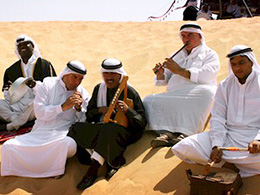 Bedwins Bedwins
Bedwins are nomadic peoples that have traditionally occupied Sinai. The word "bedwin" stems from the Arabic word, "baadiya" meaning desert. There are eight bedwin tribes in southern Sinai, the two most prominent and powerful being the El Muzeina nhabiting the southern Gulf of Aqaba area from Nuweiba to Sharm El Sheikh, and the El Tarabin inhabiting the area from Nuweiba to Taba. The total bedwin population on the eastern side of the Sinai peninsula reaches approximately 3000 individuals. The desert governs their livelihood as ancient tradition guides their life. Their culture has been founded on tradition and tribal laws. They work closely with the Park management to maintain their culture, heritage, rights, and homes. Women continue to tend the livestock (donkeys, sheep, goats, and camels), and men continue to fish according to the regulations of the Parks. Activities that may hinder the ecosystem are now regulated by the Egyptian Environmental Affairs Agency (EEAA). In fact bedwin staff have now been contracted by the EEAA as Park Rangers thus bridging the gap between the tribes and the state, both working together on behalf of the environment.
The bedwins respect nature and punish offenders. Water is carefully consumed and tribal law prohibits the cutting of green trees. They have said that "killing a tree is like killing a soul." And those who do are penalized up to three two-year-old camels, or the equivalent value. They understand the delicate relationship between coral reefs and fisheries therefore they tend to limit damage to the reefs. The EEAA tries to limit the effect of development on traditional bedwin life by helping them invest in their own knowledge. Medical care and veterinary assistance combines both bedwin practice with a limited amount of modern technology. For example livestock is treated first with local medicinal herbs before being pumped with chemicals, the answer to any problem in modern societies. The EEAA seeks to improve bedwin life by including them in the decision-making process that affect their lives. Social work includes health education, hygiene, and a veterinary program that is based on familiar bedwin treatment as opposed to modern treatment.
Recreational activities
Diving is probably the most popular recreational sport in the Red Sea. If you're not a diver, and want to explore the Red Sea, you are strongly encouraged to learn, on location! If you are a diver, you better not forget your certification card and dive log book! There are four main ways you can dive the Red Sea: daily boat diving; boat diving safari; camel diving safari; and independent shore diving. If you don't dive, or don't want to dive you can rent snorkeling equipment from any dive center and go to any shore site along the coast that is accessible by car. Consult the dive center on the most suitable places to go. Ok, so you want to see the fish, but you don't want to get wet in the process. No problem! Book an excursion on a glass-bottom and watch the corals and fish as you comfortably cruise the surface. Your hotel would be happy to help you out. There's more you can do! Na'ama Bay offers several kinds of water sport activities for everyone.You can test your wings and fly, getting a bird's eye view of the bay as you parasail.
If you're not into flying, how about skiing. You can take lessons to improve your technique or just to learn how to stay standing. Both regular skis and uniskis are available.
How about getting a bunch of friends together for a speedy ride on the banana boat. This yellow, banana like craft is tied to a long rope that is attached onto a cruising speed boat. Your goal is to hang on. The driver's goal is flip you off as he make sharp turns over the water. OK, so you want something a lot slower and laid back. You can rent a paddle boat and find some remote cove to... Well that part is up to you! Wind surfing and sailing is another popular activity. You can also take lessons, or if you're experienced, you can cruise the water pushed along only by the element of air. If you're not into diving, or you just want to take a break, there's a lot you can do with your time. Horseback riding into the desert is great fun. A guide wil l take you out and you have the choice of any kind of horse, ranging from slow walker to speedy galloper. Or you may want to climb atop a camel for a leisurely stroll through the desert. But if you'd rather have the comfort of a cushy seat, you can rent a quad runner, and speed through the desert on a lot of horsepower. Or if you're the really adventurous type, dirt-bikes and motorcycles are available for that racing spirit. Any way you go, make sure you have something to protect your eyes from all the sand that's kicked up under hooves and wheels! And somewhere in the middle of the desert sits an old bedwin man under the shade of a single tree who waits with his tea to chat with passersby. Look out for him and join him for a sweat, refreshing glass of bedwin tea, brewed on an open flame. For those of us who are really laid back, and would like to enjoy a nice ride down the boardwalk on a bicycle, stands are available from where you can rent single seat and double seat. This also makes getting places a lot quicker and easier in the afternoon heat of summer. |
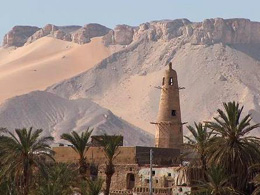 Western Oasis
Egypts vast western desert stretches over nearly 3 million Kilometer square, from the west bank of the Nile to Libya, and from Sudan towards the Mediterranean Sea. Despite covering over two-thirds of Egypts total land area, the desert is virtually uninhabited, except for the fertile oases where communities and crops flourish amid barren desert surroundings.
There are five oases in the Western Desert: Siwa, Kharga, Dakhla, Farafra and Bahariya. Except for Siwa, the oases have been under the control of the rulers of the Nile Valley since Pharaonic times, when they were crucial stopping points on the busy caravan trading routes from Africa. The Ptoletmaic temples and Roman forts dotted around the oases bear witness to their past importance and ongoing archaeological work is continually uncovering new finds. Each of the Western Desert oases has its own unique character. While the main settlements of Bahariya and Farafra are still villages, those of Dakhla and Kharga are large towns, surrounded by fascinating historical sites. In Siwa, isolated near the Libyan border, the inhabitants retain their own language and distinct culture.
In the late 1950s a plan was made to reclaim part of the desert and relocate thousands of people from the crowded Nile delta and valley. The area, covering Bahariya, Farafra, Dakhla and Kharga oases, was named the New Valley. Although some building began, few people moved, and financial constraints together with the questionable sustainability of the water supply meant that the project was virtually abandoned. The Western Desert today remains one of the few places in the world where travelers can experience a feeling of total isolation. Its sheer scale is overwhelming. From huge dunes to fantastical rock formations, the landscape varies dramatically and camping out overnight in such astonishing surroundings can be one of the highlights of a trip to Egypt. |
|
|
|
|
|
|